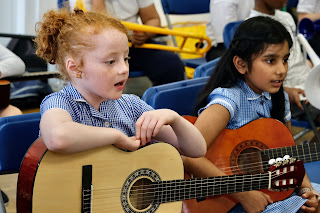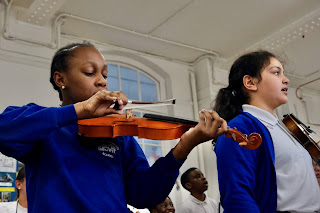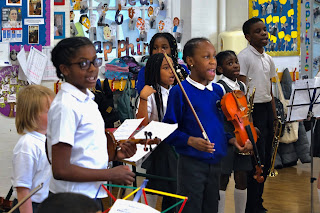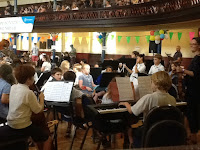Spring 2023
Have you heard of the composer Florence Price? Did you know she wrote over 300 pieces of classical music? You can find out more here.
Florence B. Price lived from 1887 - 1953. She was an African American woman writing music despite sexist and racist barriers in America at the time. We are really excited to be exploring her music, and we are starting to learn an arrangement of 'Juba Dance' - the 3rd Movement from her Symphony No. 1 in E Minor. Here's an introduction to Florence and her music, and a recording of the whole piece. Listen and get to know the rhythms. Can you hear when the main melody comes in?
Have you heard of the composer Florence Price? Did you know she wrote over 300 pieces of classical music? You can find out more here.
Florence B. Price lived from 1887 - 1953. She was an African American woman writing music despite sexist and racist barriers in America at the time. We are really excited to be exploring her music, and we are starting to learn an arrangement of 'Juba Dance' - the 3rd Movement from her Symphony No. 1 in E Minor. Here's an introduction to Florence and her music, and a recording of the whole piece. Listen and get to know the rhythms. Can you hear when the main melody comes in?
We made up a song to help us to learn the rhythm and melody of the main theme:
It's the Juba I dance
The Juba I dance
The Juba's the dance for me!
The Juba I dance
The Juba's the dance for me!
Price's original work includes djembe drums - especially exciting for the djembe drummers in our group. Here's their rhythm in the same section:
I can do the Juba
Yes I can now!
Yes I can now!
This is repeated over and over again to make an ostinato accompaniment.
Maybe you can find some more pieces by Florence Price to listen to. Do you like her style?
Autumn 2022
Wow - the Autumn term flew by! But we have been working hard in orchestra. We have been learning another folk tune - Buttered Peas - and a little Christmas tune that you will definitely recognise.
We've had a few new members, a member who is learning to conduct, and a new percussion section! As a group we've been working on balance (being able to hear all of the instruments playing, especially whoever is playing the melody) and on the tempo - playing at the same speed together. To play a folk tune faster, we sometimes need to play more lightly. We were also thinking about which rhythms we wanted to emphasise.
Here's our performance in the final Star assembly of 2022.You can hear for yourself how we are getting on!
Summer 2022
Winster Gallop
We have a new folk tune to learn - the Winster Gallop. This is a ceilidh tune - perfect for dancing to. Have a listen below and see if you can play along. Can you get your playing up to speed? Start with the slow version and progress to fast!
Skat Cat Swing
Our instrumentalists are busy practising for a big band performance of Skat Cat Swing in March/April.
Here's the learning and backing tracks to practise with at home! More soon...
Music for Youth Remix Prom - 3rd November 2021
Congratulations to the children in Years 5 and 6 who have been invited to take part in the Remix prom in a few weeks. Remember to learn the song and practise the musical cues with your instruments (and some other objects!). Use the videos below to help you:
If the videos aren't playing in the blog, you can also find them on the Music for Youth page here: https://www.mfy.org.uk/get-involved/mfy-remix-prom-2021/remix-prom-resources/
Our next rehearsal will be Wednesday 13th October at 2.30pm!
Hackney instrumental Festival - July 2021
In July, our instrumental players, and some of our community choir singers from Years 3 to 6 took part in the virtual instrumental festival, run by the Hackney Music Service. We played our own arrangement of Canon in D by Johann Pachelbel (assumed to be written sometime between 1680 and 1706) with 1990s pop song All Together Now by The Farm and a rap and harmony part about our three school rules: We are ready, we are respectful, we are safe.
You can listen to the final piece in the first video, and check out the whole festival featuring many other Hackney schools alongside Queensbridge in the second video. What other musical groups would you like to see at Queensbridge?
We are so proud of all of you for accomplishing this in a tricky year with Covid restrictions and lockdowns. You did an amazing job of learning your parts on all of your different instruments, so that we were able to put together this performance with only 2 whole-group rehearsals. For some of you it was the first time playing together in an ensemble. Well done. We can't wait to see what you can achieve next year. Here are some pictures of our wonderful orchestra members:
Summer 2021
Wow - what a year it has been. We haven't managed to meet as an orchestra during the pandemic so far, but this summer we are planning some outdoors rehearsals, and a special video performance with a special arrangement of Pachelbel's Canon, and All Together Now, by the Farm. Listen to these and read more about the project below!
This will be a joint project between orchestra choir - and anyone who wants to join in! We are going to learn 'Canon and Gigue for 3 violins and basso continuo' by the German composer, organist and teacher, Johann Pachelbel. It's a very famous piece, also known as Canon in D, and has also been used as the basis for many pop songs and music in other genres.
Start by listening to the piece. I like the strings version above. Try to play it once without watching the video. Sit back and listen with your eyes closed. Can you hear the different instruments coming in after each other? Now play it again and have a look at the animation, or 'graphic score' that someone has made. Can you see how the different instruments are playing the same music, but starting at different times - just like the way we sing rounds in assembly? A CANON in music is the same as a ROUND!
The next video is of a pop song called All Together Now, by a band called The Farm. The song was written in 1990 and was inspired by the truce in World War I where German and British soldiers played football together on Christmas Day, 1914. Can you hear how they have used Pachelbel's music to build their pop song? We can use the chorus of All Together Now to make a special song for Queensbridge School?
Our more advanced orchestra players have been learning the main theme for the Juba Dance from the third movement from Symphony No. 1 in E Minor by Florence Price. Here's a sneak preview! Orchestra - don't forget to practise along with the piece on the BBC Ten Pieces Trailblazers website.
Spring 2020
Today we started listening to a new piece to learn - the third movement from Symphony No. 1 in E Minor by American composer, Florence Price (1887-1953). This awesome piece is based on the Juba dance which was traditionally done to body percussion. Florence Price incorporated these ideas into a full orchestral work. You can find out more about this trailblazer and listen to the music at BBC Ten Pieces. Everyone in the orchestra will get some music to practise at home, and we hope to perform this at the Round Chapel in the summer.
We have also been experimenting with some music in 11/8 - quite a tricky time signature! Watch this space.
Autumn 2019
We've 'kicked' off our new term in orchestra with a traditional English folk tune called Donkey Riding. It's pretty good hearing it in 3 parts after only 3 rehearsals. Here's a sneak preview during orchestra practice last week:
 The orchestra gave a wonderful performance at the Round Chapel today, as part of this year's Hackney Music Festival. Well done orchestra for all of your hard work and practise. Many of you were learning new notes as we went, as well as the pieces. Thanks to the teachers and parents who came to support us as well.
The orchestra gave a wonderful performance at the Round Chapel today, as part of this year's Hackney Music Festival. Well done orchestra for all of your hard work and practise. Many of you were learning new notes as we went, as well as the pieces. Thanks to the teachers and parents who came to support us as well. Here are some clips of the performance:
Royal March of the Lions by Saint Saens (arr. Queensbridge Orchestra)
The Lion Sleeps Tonight by Solomon Linda (arr. Queensbridge Orchestra)
Full audio recording of the pieces above!
1st March 2019
Today, the percussion and keyboard players started learning Fossils:
Here's the original music for Fossils. We'll have to practise to increase the speed! Can you spot the two nursery rhymes hidden in the music? Which instruments are playing?
30th January 2019
Thanks to the string players who made it to orchestra today. We were practising a scale to play all of the notes of the main tune of March of the Lion. Can you play along with this track to practise your tuning? Violins - start on the A string and go over onto the E string. Remember the 2nd finger on the A string is right next the first finger in this scale, then a big stretch for the 3rd finger. Cellos start with a 1st finger on the G string and go over onto the D string. It's quite tricky but it will improve with practise!
Spring Term 2019
This term we are going to start work on learning movements from Carnival of the Animals by the composer Camille Saint-Saens. We are starting with The Royal March of the Lions, and arranging it for the instruments in our orchestra.
Here's a recording of the whole work. Enjoy listening!
And some more information about the piece, from Wikipedia:
Le Carnaval des Animaux (The Carnival of the Animals) is a musical suite of fourteen movements by the French Romantic composer Camille Saint-Saëns. Le Carnaval was composed in February 1886 while Saint-Saëns was vacationing in a small Austrian village. It was originally scored for a chamber group of flute, clarinet, two pianos, glass harmonica, xylophone, two violins, viola, cello and double bass, but is usually performed today with a full orchestra of strings, and with a glockenspiel substituting for the rare glass harmonica. Saint-Saëns, apparently concerned that the piece was too frivolous and likely to harm his reputation as a serious composer, suppressed performances of it and only allowed one movement, Le Cygne, to be published in his lifetime. Only small private performances were given for close friends like Franz Liszt. Saint-Saëns did, however, include a provision which allowed the suite to be published after his death, and it has since become one of his most popular works. It is a favorite of music teachers and young children, along with Prokofiev's Peter and the Wolf and Britten's The Young Person's Guide to the Orchestra. Introduction et marche royale du Lion (Introduction and Royal March of the Lion) Strings and two pianos: The introduction begins with the pianos playing a bold tremolo, under which the strings enter with a stately theme. The pianos play a pair of scales going in opposite directions to conclude the first part of the movement. The pianos then introduce a march theme that they carry through most of the rest of the introduction. The strings provide the melody, with the pianos occasionally taking low runs of octaves which suggest the roar of a lion, or high ostinatos. The movement ends with a fortissimo note from all the instruments used in this movement.
This is worth a watch if you'd like Bugs Bunny and Daffy Duck to guide you through the piece. There's also footage of a live orchestra.
The orchestra are busy preparing for the Christmas performance of Alice in Wonderland. The children are getting their heads around the tricky rhythms of 'Wonderful World, Beautiful People' by Jimmy Cliff. We hope it comes together in time! We are also creating a fanfare and bubbly sound effects for certain scenes in the show. Don't miss it!
Summer 2018
Queensbridge Orchestra played in the Hackney Music Festival instrumental day at the Round Chapel. We played a section from Antonin Dvorak's New World Symphony, leading into the Hoedown from the ballet Rodeo by Aaron Copeland. Our set finished with Uptown Funk by Mark Ronson. We had lots of really positive feedback from teachers and parents alike. You can watch our performance here:
Here are some photographs and clips of us joining in with the James Bond Theme Tune. All of the children from different schools joined in with learning and performing that one!
After a brilliant start to the year, playing Nanuma in a concert also featuring Fleur East, the Queensbridge Orchestra has welcomed quite a few new members, and is on fine form. We are excited to be learning Hoe-down from the ballet Rodeo by Aaron Copeland.
Yeee-ha! There's a hoe-down at the Rodeo.
Cowboys come; Get your horses ready, off we go!
Cowboys come; Get your horses ready, off we go!
This orchestral pieces features as one of the BBCs TEN PIECES III - You can find out loads more information about the piece and watch the BBC orchestra playing it in full here
Here's a clip of the Queensbridge orchestra strings and wind sections practising this week - the first time they have properly looked at the sheet music. We have also been working on the rhythms and the intro. Next week will be percussion and piano rehearsal! Don't forget to practise your part at home!
Spring 2017Here's a clip of the Queensbridge orchestra strings and wind sections practising this week - the first time they have properly looked at the sheet music. We have also been working on the rhythms and the intro. Next week will be percussion and piano rehearsal! Don't forget to practise your part at home!
This Spring term, the orchestra at Queensbridge has begun learning Hey Brother, by the Frightnrs. With such talented musicians in the orchestra, we already have the outlines of the rhythm and melody, and are now adding harmonies and learning to improvise along to the music. Here is the song on YouTube to help you to practise at home! Enjoy this song with a great message for all of us...
Music For Youth Festival
The Orchestra and Chamber Choir enjoyed their performance at the Music For Youth festival at The Union Chapel in March 2016. During Orchestra we asked the children how they thought the performance went, this is what they said...
"I was proud to play an amazing piece of music in front of other schools and professional musicians"
"I was really excited to play in such a big venue and we did a really good job"
"I thought about the music and not the people watching"
"It was scary because people were looking at us, but fun because we did well and everyone was pleased."
"I enjoyed listening to the other groups"
Stravinsky's Firebird
This is a video of us (from Summer 2015) performing the main theme from Stravinsky's Firebird Suite, along with some improvisation on different sounds and playing techniques. Can you hear how the texture and dynamic builds as we add more and more instruments? Enjoy!
Workshop with the Worshipful Company of Musicians
 In Autumn term we were visited by the conductor Adam Kornas. He told us about his job, and how the conductor keeps the players in time, as well as helping to shape the musical performance by showing dynamic and speed changes.
In Autumn term we were visited by the conductor Adam Kornas. He told us about his job, and how the conductor keeps the players in time, as well as helping to shape the musical performance by showing dynamic and speed changes. We learnt to watch the end of the conductor's baton very carefully as Adam helped us to practise Autumn from Vivaldi's Four Seasons.
Adam also asked us to find sounds on our instruments that related to the season of Autumn. We blew into the violins to create windy sounds, and played descending scales to suggest the leaves falling. It was good fun putting the sounds together to make an Autumn soundscape.
 |
| Are you ready? |
 |
| Brass and woodwind making a great sound. |
 |
| Violins ready to play - together! |
Southbank Sinfonia Concert Trip
 In summer 2015 the orchestra visited St John's Church in Waterloo to watch and hear the Southbank Sinfonia orchestra. It was so exciting to hear a professional orchestra. They played the Duet Concertino by Richard Strauss. We heard the clarinet and the bassoon playing music for the characters of a princess and a bear, who begin nervously, but end up dancing together.
In summer 2015 the orchestra visited St John's Church in Waterloo to watch and hear the Southbank Sinfonia orchestra. It was so exciting to hear a professional orchestra. They played the Duet Concertino by Richard Strauss. We heard the clarinet and the bassoon playing music for the characters of a princess and a bear, who begin nervously, but end up dancing together. The presenter and the conductor taught us lots about music, including the meaning of the words 'tremolo' (a scary, tense and dangerous sound) and 'duet' (two people playing together).
The children from Queensbridge were very eager to answer questions, as you can see in the photo!






















































No comments:
Post a Comment
We love to hear your views, but please comment respectfully and don't add any links. Thank you.